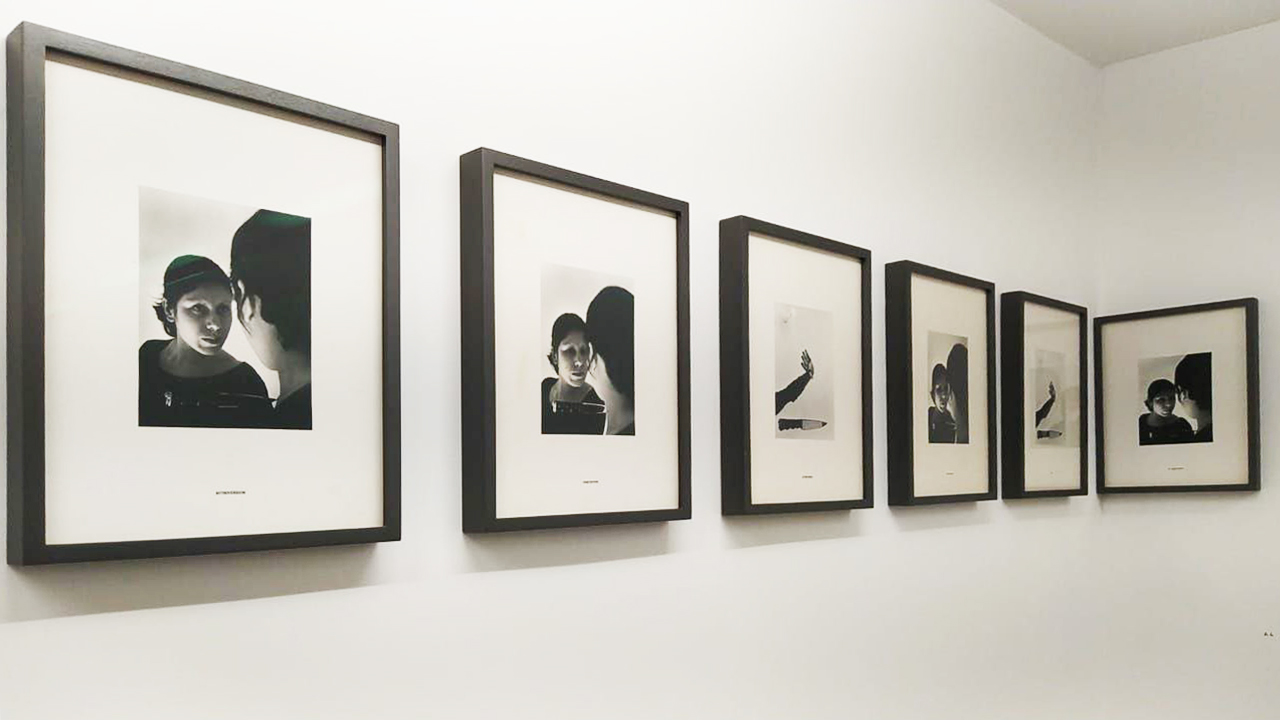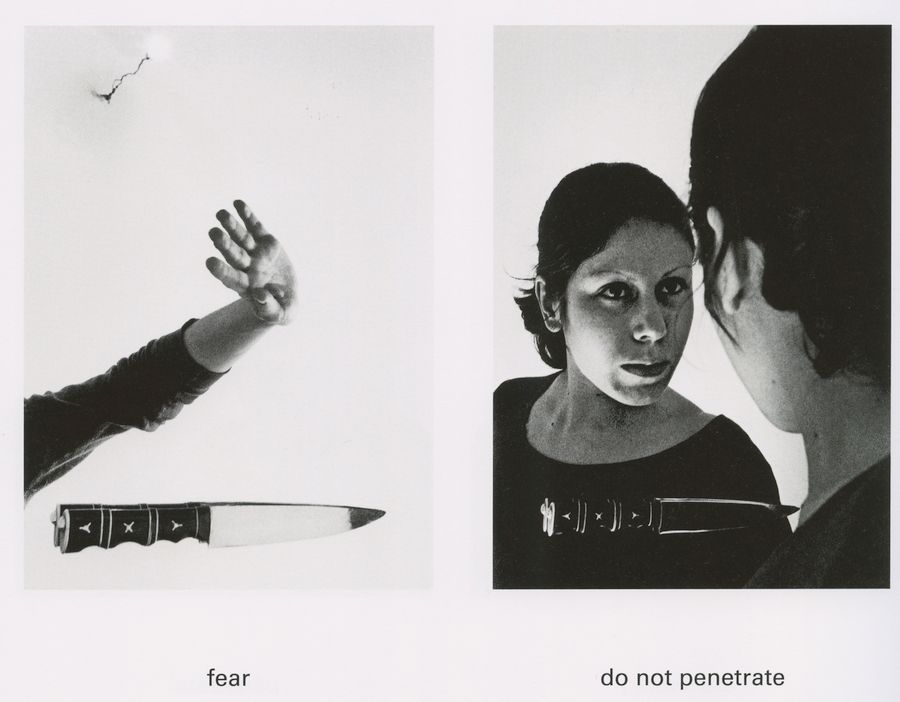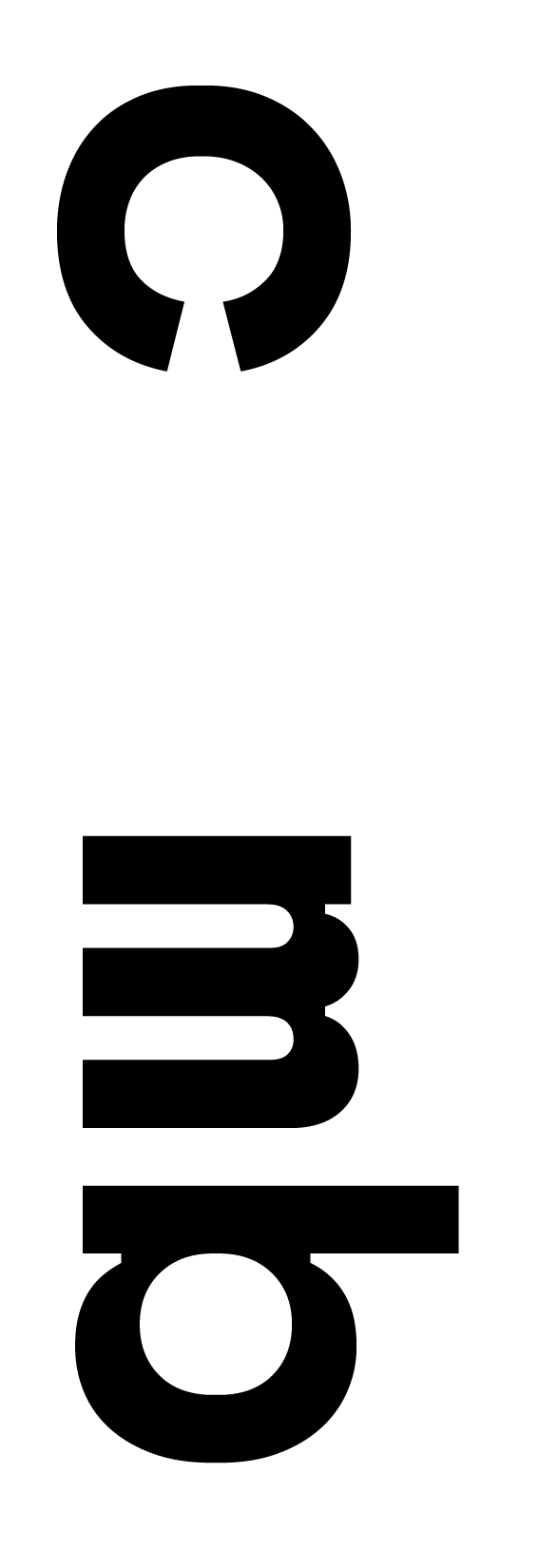The reflection of the knife
Caio Bonifácio
Renata Masini Hein
In Portuguese and English, “penetration” has a sexual meaning.
The knife, or the phallus, penetrates the flesh.

1. the image
Fear/No penetration is a photographic composition made in 1973, a period in which Iole de Freitas worked mainly with photography and Super 8 videos.
At that time, the artist already had more than eighteen years of experience with contemporary dance. In this and other works from the early 1970s, the body is present, mediated by the camera and a mirror.
Fear/No penetration is a montage of two side-by-side black-and-white photographs. In them you can see the artist and a knife placed next to a mirror, which makes her reflection go almost unnoticed. We know about the reflection because we know that mirrors reflect. Also by the smooth duplication of the handle.
The first image, on the left, is associated with the term Fear and presents a body without reflection in a gesture of refusal or withdrawal - directed at the image in the mirror itself or at a third element outside the frame. The second photograph, on the right, is associated with the phrase No penetration and suggests a confrontation: the knife stays between the artist and her own reflection in the mirror, while she stares at herself, eye to eye, with an expression of courage.
"You have to be alert and strong
We don't have time to fear death”1
We don't have time to fear death”1
1 Excerpt from the lyrics of the song "Divino Maravilhoso" (Caetano Veloso/Gilberto Gil), interpreted by Gal Costa on the 1969 record, "Gal Costa."
Iole is part of a wave of artists who left the country in the 1970s and won the favor of an international audience that had its eyes set on Brazilian artists.2 In 1973, when she conceived the composition Fear/No penetration, the artist lived in Milan where she worked as a designer.
Her work is underscored by this internationalist wave of Brazilian production, and we can consider that this intersects with the work discussed here in at least three points: i) in the text in English under each of the photographs, which, as a lingua franca, testifies to the construction of the ongoing hegemony of Anglophone culture; ii) in its circulation in the global north during the 1970s, with several exhibitions in Western Europe, the United States and Canada; iii) in its reception by international critics, mainly its inclusion in the feminist art criticism that began to develop in the 1970s.
Her work is underscored by this internationalist wave of Brazilian production, and we can consider that this intersects with the work discussed here in at least three points: i) in the text in English under each of the photographs, which, as a lingua franca, testifies to the construction of the ongoing hegemony of Anglophone culture; ii) in its circulation in the global north during the 1970s, with several exhibitions in Western Europe, the United States and Canada; iii) in its reception by international critics, mainly its inclusion in the feminist art criticism that began to develop in the 1970s.
2 At least since the disclosure by the English critic Guy Brett of tropical inventiveness – a distinctive feature of Brazilian art – present in the appropriation of constructive trends by neo-concrete artists.
3. the photography of the body
Iole's face only appears in the second photograph, the gesture of refusal with the hands directed to an unseen other outside the field of representation: an other that escapes her strategies, like a hole, like a trauma.
In Fear/No Penetration, a gesture of refusal is projected onto the surface of the mirror: the outstretched wrist that keeps the hand bent back, with the fingers slightly bent. A movement that appears only mediated by another surface, on which one can see one's own body reflected.
Iole's face only appears in the second photograph, the gesture of refusal with the hands directed to an unseen other outside the field of representation: an other that escapes her strategies, like a hole, like a trauma.
In Fear/No Penetration, a gesture of refusal is projected onto the surface of the mirror: the outstretched wrist that keeps the hand bent back, with the fingers slightly bent. A movement that appears only mediated by another surface, on which one can see one's own body reflected.
A gesture is a need for bodily expression to fill an act of affection – it is aesthetic. Familiarity with a specific movement allows for gesticulation, which expresses an unknown dimension of oneself. It is the unconscious of movement, which demands to rise to the surface – the cut of the body through photography is also an analysis of the recesses of the psyche.
The production of Bruce Nauman, for example, a contemporary of Iole, is layered with the submission of the body to conditions of restriction of movement, in which an affected gesture is forced or struggles to appear. Walking in a tight corridor in contrast with a Greek sculpture at rest. Or walking over a marking on the floor, a square, sterile. The body manifests itself even in an arid environment.
In the choreography of Accumulation (1971), Trisha Brown isolates some small movements of isolated body parts – like something fabricated, machinic. She repeats these movements and adds others, forming sequences through accumulation. Nothing more than that, accumulation of simple steps. In the intervals, in the repetition, the body plays with style, with gesture.
In the 1970s, Lucy Lippard produced a catalog of Iole's work.3 In the introductory text, Lippard indicates that the artist's procedure in relation to the body involves a thorough analysis, from fragmentation to investigation, aiming at a later reconstruction “of macrocosmic form, like art.”
The mirror and photography allow us to see the body projected on an external surface, for investigation and production of knowledge – which allows, at the same time, care and domination. The body appears as a virtual image (as a double: there is Iole photographed and there is her reflection in the photographed mirror), projected and mediated.
The mirror and photography allow us to see the body projected on an external surface, for investigation and production of knowledge – which allows, at the same time, care and domination. The body appears as a virtual image (as a double: there is Iole photographed and there is her reflection in the photographed mirror), projected and mediated.
3 The presentation text of this catalog can be accessed at: http://www.iacbrasil.org.br/acervoiac/static/iac/uploads/acervo/arquivos/29234.pdf
How many times do you make the refusal gesture before you see what's there? Various.
About her photographic practice, Iole wrote:
The analytical use of the photographic image is related to the epistemological model of the camera obscura, generally considered to be a primitive stage in the genealogy of photography: the camera obscura produces an isolated picture, projected inside a dark room, separate from the extensive world.5
This dark environment is the ideal model, where the observer's body is not under the conditions of the real world from which the picture is taken - the relationship between subject and object takes place in the laboratory.
Using photography as a means of expression interests me as much as it allows me to record the mood of my state of mind. My body was photographed by myself; if someone else operated the camera, the resulting image would not be one wherein I alone can intervene at any time. [...] I mean, I want to register more than document, through a planned image, certain moments that are part of an intimate research, to reach a better knowledge of myself. [...] the resulting images are supported by a rational organization that itself refers to a dialectic of language as it appears from the opposition of images and words.4
The analytical use of the photographic image is related to the epistemological model of the camera obscura, generally considered to be a primitive stage in the genealogy of photography: the camera obscura produces an isolated picture, projected inside a dark room, separate from the extensive world.5
This dark environment is the ideal model, where the observer's body is not under the conditions of the real world from which the picture is taken - the relationship between subject and object takes place in the laboratory.
4 Originally written in Italian, the text written by Iole is a presentation of the work “Introvert/penetrate; extrovert/penetrate; fear/do not penetrate,” six photographic sequences from 1973, which can be accessed at: http://www.iacbrasil.org.br/acervoiac/static/iac/uploads/acervo/arquivos/29159.pdf
5 The idea of the extensive world follows the formulation of the res extensa in Cartesian thought. It is the notion of an uninterrupted world, under which rational fragmentation does not exist. On this and other transformations in thinking about vision, see CRARY, J. Técnicas do observador. São Paulo: Contraponto, 2012.
5 The idea of the extensive world follows the formulation of the res extensa in Cartesian thought. It is the notion of an uninterrupted world, under which rational fragmentation does not exist. On this and other transformations in thinking about vision, see CRARY, J. Técnicas do observador. São Paulo: Contraponto, 2012.
The camera also allows the capture of a static world in a predicted geometric grid – the device produces a series of deformations of the captured image, with calculations for the transformation of the multidimensional complexity of the world into a two-dimensional image.

Lippard wrote: “Through fragmentation, seeing herself piece by piece, she manages to recreate herself as well as evoke movement, using a static medium over which she has complete control.”
Aware of the opacity of the language she investigates, the artist can consider the distortions caused by the lens in her detailed and critical analysis of her own body.
Aware of the opacity of the language she investigates, the artist can consider the distortions caused by the lens in her detailed and critical analysis of her own body.
4. the knife penetrates the meat
The knife, the phallus.
A knife that appears suspended and fixed horizontally on the surface of the mirror.
There are also knives in other works by Iole from the same decade: cutting fabric, wielded by the artist; in front of several shards of broken mirror that reflect her face, the knife appears as a destructive force of the surface where the body is projected: does it represent a threat to identity or to the mediation of the reflection?
Phallus = D: Phallus. — F.: phallus. — Port.: falo. — Span.: falo. — /.: fallo.
In Greco-Latin Antiquity, figurative representation of the male sexual organ. In psychoanalysis, the use of this term underlines the symbolic function performed by the penis in the intra- and inter-subjective dialectic, while the term “penis” is mainly reserved to designate the organ in its anatomical reality.6
The knife, the phallus.
A knife that appears suspended and fixed horizontally on the surface of the mirror.
There are also knives in other works by Iole from the same decade: cutting fabric, wielded by the artist; in front of several shards of broken mirror that reflect her face, the knife appears as a destructive force of the surface where the body is projected: does it represent a threat to identity or to the mediation of the reflection?
6 LAPLANCHE, J.; PONTALIS, J. B. Vocabulário de Psicanálise. São Paulo: Martins fontes, 2008, p. 166 - 167.
Following Lippard's reading, in these cases, the knife would symbolically be a liberation from the socially imposed image for women of an “enslaving femininity.” “The knife is therefore a symbol of freedom.”
In this investigation of the body, Iole first registers an emphatic refusal, the hand outstretched in fear. If in the first image the knife appears suspended, offered to the not-represented other and refused by the artist, in the second, her eyes stare at the knife, contemplating the possibility of a violent attack: cutting her reflection or her opponent.

